The idea of “nostalgia” anything in drag racing other than Don Garlits making burnouts in Swamp Rat 1 is kind of a joke. Nostalgia funny cars? Look at some photos from the late 1960s or early 1970s and show us the similarities between the two cars. Oh, yes they do both roll on four wheels. We’re not saying that this is a bad thing, quite far from it really. Stuff that looks simplistic and old school to the casual observer is often hiding an incredible amount of advancement and technology that true fans and enthusiasts can dive into.
Such is the case with the machine that we’re going to show you from end to end in this story, the B/Nostalgia Dragster of Massachusetts based racer Chuck Waters. You may remember Chuck’s name as he was an alcohol dragster competitor in the 1990s before taking a hiatus from the sport (his career bests are 5.97/233). A couple of years back, he delved headlong into this project and it has come to a head with one of the finest examples of an NHRA legal B/Nostalgia Dragster that exists anywhere in the world today.
“I have always loved front engine dragsters and have wanted to do this for a long time,” Chuck told us. “This style of car can be run a bunch of different places and in different classes like 7.0 pro, at nostalgia races, and we want to have a lot of fun with it.” He continued, “People don’t realize what goes into these things. The more you look the more you will see, that is for sure.”
For starters, B/Nostalgia Dragster is a class inside the NHRA’s sprawling Competition Eliminator category that contains a near infinite variety of cars. The approach in comp is different than virtually any other form of NHRA racing in the fact that the cars run a handicapped tree but have no breakout so first to the finish line wins and moves on. Classes are set on individual indexes that determine the handicap so you need to have something that’ll really tattoo that index to make sure you have enough ponies in your back pocket to win. We could spend hours on this topic but we’ll let it sit right there. You know what the weapon is designed for, now let’s look at what this car actually is.
Chassis –
With a wheelbase measuring out at the class maximum 225″, the 2012 Neil and Parks chassis was built for Chuck specifically. He was fitted to the car as it was being constructed and he was able to spec it out the way that he wanted while dealing with the well known Kansas shop. Waters chose Neil and Parks because they are known as “the” guys to go to for one of these cars and have been for some time. We’re a long way from the days of guys like Woody Gilmore and Don Long in the engineering department here. Other than the fact the big tires are out back and the little ones are out front, it is all new and improved.
All of the tubing ahead of the driver’s area is .049 wall chromoly steel. The driver’s area follows all of the SFI specs in its construction with heavier tubing and the necessary bars. There have been design changes over the years as racers have determined what works and one of the biggest decisions has to do with the placement of the engine. In this case the engine is 48″ out. That measurement is the rear axle centerline to the rear motor plate. If you look at cars of older construction the engine is not as far down the chassis, but in something that was almost counter intuitive the Neil and Parks guys learned that by pushing the engine further toward the front end it made the car hook and book better.
The car has a limited number of body panels because of weight. You will learn in this story that weight is the primary concern of this build. Getting rid of it and then concentrating it in the right places to make the car function better. The body panels are magnesium. The cowl and nose piece are carbon fiber. The entire machine with its iron motor installed and no driver or ballast comes in at a nearly shocking 1,070lbs. Race weight is 1,360 with Chuck and ballast aboard.
Front end –
It seems logical for us to start at the front of the car and move our way back. This (to us anyway) is where the really cool stuff starts. So much of this car is just below the surface that the casual fans would never actually appreciate what they’re looking at here. Those wire font wheels are made by a company called Hayden Enterprises and not only are they cool, but they are also trick in their own way. The spokes are all sealed so that the front tires are not required to run a liner, which is a weight savings. They have ceramic bearings which have almost no drag, literally. We spun one of the tires a couple weeks ago and it may still be spinning now.
The nose piece covering the 2.5 gallon fuel tank is made of carbon fiber and came with the car from Neil and parks. We LOVE the cool aerodynamic vent that has the look of a (former) pro stock hood scoop. That’s an important piece to help ramrod the fuel down the very long titanium fuel line in the center of the car. The pin striping is a wonderful touch that we’ll hit on a little later. These cars are mandated to run methanol fuel, so that’s what lives in this tank.
The car uses aluminum spindles, titanium tie rods, magnesium hubs, and a titanium steering rod. This is all held together with titanium nuts and aluminum bolts. Once again, the class may have the word nostalgia in its name but this is literally space age stuff and we’re just getting going. There are no brakes on the front end as you can see.
Engine and transmission –
Those people that have a passion for this class are drawn to it for a couple of reasons. Our reason is sitting in the photos below. The naturally aspirated small block engines that push these cars to elapsed times in the 6-second zone (quarter mile) and speeds of nearly 190mph are like the cars in which they are bolted. A study in how to elevate something old into a pretty amazing marvel of technology. The most refined hammer you’ve ever seen, this is a small block that everyone can love. Gregg Hekimian Racing Engines in Watertown, Massachusetts was a huge part of this build and Chuck was very quick to thank him for all the work that he put into this awesome little engine.
Class rules state that the block and heads must be iron so that’s what they are. A Dart Iron Eagle block is the basis for the engine. The compacted graphite iron lump shed 30lbs after a bout with a CNC machine. The heads are 23-degree iron castings from RHS that have been heavily worked by CFE. The runners have been raised, and because the rules allow a +/- change of three degrees in the valve angle the valves in these are now at a 20.5-degree angle. The heads have 2.25″ intake valves and 1.60″ exhaust. The valves and basically the entire valve train are titanium. There’s a COMP solid roller cam with an inch of lift on the intake side opening the valves and the PAC Racing springs along with the Jesel lifters get a real workout handling the valves at 10,000 RPM! Many of the engine components have been cryogenically treated for strength. This is serious business.
Below those heads are a set of 15:1 compression Diamond piston that have their tops and skirts coated. The pistons have the most minuscule ring pack that Diamond offers and gas ports to aid in ring seal. A Star vacuum pump is an integral piece of the oil control program. The crank is a Callies piece that weighs 35lbs and swings Bill Miller aluminum rods that hold the pistons in place with titanium wrist pins. The engine uses 283 Chevy sized mains and Olds Aurora sized rod journals. The best cars in the country are making 875-900hp on the dyno and Chuck tell s that peak torque is made near 8,800 rpm. Wow!
This engine has never seen a dyno to this point, only the track in early testing.
Believe it or not there are guys running titanium zoomies. Chuck is not one of them. These steel pieces do just fine moving the spent gasses away from the engine and screaming like the devil’s pipe organ at the top end when the rev counter goes into the five digit zone.
The ignition system on the car is an MSD 20-amp Pro Mag magneto.
No, that’s not aluminum. The front drive on the engine is made of magnesium in yet another nod to managing weight. You can also see that bad daddy of a vacuum pump that is an essential part of managing the oil in the car at the huge RPM the engine turns and with the ring package that the Diamond pistons wear.
The fuel line is .020 wall Titanium tubing. We’re sorry but that is flat out bad ass.
The fuel system is another cool element of the engine. Starting with a billet Hilborn mechanical pump, the methanol is fed into the port injected Kinsler manifold. You can see the lines below. This until is known as the Mini-Monster according to Chuck and it was developed by guys like Dean Carter who have been a driving force in the category since its inception. These are 2 7/8″ butterflies. That is the max size to meet the specs for B/nostalgia dragster. A/nostalgia dragster entries are allowed more than three inches for each hole. Chuck estimates that the pump is moving about three gallons per minute at the stripe. Yeah, that little fuel tank is about sucked dry by the time the car is done!
The oiling system is a Peterson five stage dry sump. Even the tank is a work of art.
Transmission and rear end –
Transmissions must be two speeds in the class and Waters has chosen to go with a Neil and Parks built, Reid case equipped Powerglide. Gearing is essential in here and it is one of the few places in the car where a true secret may lurk. Lots of different ratios are used to get these flyweight machines moving. As you would expect the blow proof case is full of lightweight components. There’s an Aluminum drum and plates, an aluminum valve body, an aluminum output shaft, and a magnesium shorty kit used. When the car’s racing weight is 1,360lbs you can get away with that. Try it in your Chevelle and you’ll likely not be so fortunate. The couplers used to secure the driveshaft are aluminum and the driveshaft itself? Yeah that is gun drilled titanium.
The torque converter is an essential link in the car that can take a great engine package and make it look heroic or if wrongly tuned make it look like a weak dog. Waters started out with a 8,200 stall converter and it was not what the car wanted. So he has updated since these photos were taken to an 8,800 stall converter which will be put to the test when he gets back out to the track in the Spring. The converters were sourced from A-1. He feels that a bolt together aluminum converter will ultimately where he ends up when all is said and done.
With the cowl removed you can see the “office area” and there’s not a whole lot of room to spare in there!
Aluminum couplers and a titanium driveshaft keep the power heading to the rear axle.
The rear axle is fascinating and the more perceptive of you out there already know why. The center section is a drop in 9-inch for style piece but the ring and pinion layout is taken from the 12-bolt GM axle. As Chuck told us there is less parasitic loss in having the pinion gear mounted in a higher position on the ring gear. The housing was made by Neil and Parks. You can see that it has been built as light as it can be made while maintaining strength. There is a 4.88 gear ratio in there currently. Even the ring and pinion are touched. In this case the backs of the gear teeth have been profile milled. There is an aluminum spool in the axle and the bolts holding the ring gear to it are titanium. The brakes are carbon discs by Strange and the wheel studs are (say it with us now) titanium. The axles are also Strange. They are gun drilled and use helicopter style flanges to save weight.
Data –
Chuck is tracking multiple channels of data on his RacePak V300SD. What are they?
- G forces
- engine rpm
- driveshaft rpm
- crankcase vacuum
- eight exhaust gas temp sensors
Exterior mechanical and body/paint –
Again, to the untrained eye or the uneducated person there’s not much happening on the outside of the car. But look a little further and you’ll see that there’s a TON going on both mechanically and creatively.
The car wears lightweight Bogart wheels. Limited to a 12″ wheel and a 12″ slick by the rule book, both are very advanced and take things to the extreme. The wheels are super light weight double bead locks. All of the hardware in the wheel is titanium. The slick are even lightweight! Goodyear D2585 model tires weigh in at only 22lbs a piece and are run with no liner.
The story behind the car’s name and the paint scheme are awesome. The creative idea behind the scheme came from Chuck and his girl Cathy. Both are both mechanical engineers who work in the defense industry on guidance systems for missiles. When trying to come up with a name for the car it was Cathy who locked it down and then they had the genius idea of adding a special touch to the car.
The special touch are those equations slathered up and down the side of the machine. They were created by a guy named Charles Draper. Who was he? Draper was one of the most brilliant minds of the 20th century and while a professor at MIT he developed the guidance computers that would ultimately put man on the moon in 1969. Heady stuff.
As it turns out Chuck and Cathy had a coffee mug with many of these important equations on it and those equations were laid onto the car by Nub Grafix in Walden, York. Nub also did the pin striping on the car and the work on the cowl with the name of the machine and the bad ass illustration.
The cowl piece is carbon fiber but the body side panels are .032 thickness magnesium. How awesome is the paint and the lettering?! The canard wings have carbon fiber spill plates and the wing section is formed from magnesium.
Chuck Waters in the office and some closing thoughts –
Below we have some photos that show what it looks like when Chuck is in the car and “at work”. You can see how nicely the machine fits him and how in the notable fashion of all slingshots his legs are draped right over that axle housing. Everything falls right at hand for him from the wheel to the brake handle. The car is truly awesome.
In early testing last Fall Chuck went 7.1 at 184mph with a less than ideal converter and very little seat time. They had the rev limiter way down in safe mode and the car was generally soft as he was licensing. We’re super pumped to see what it will do in the Spring when he rolls it to New England Dragway and really give the thing the beans!
Chuck wanted to give special thanks to his girl Cathy McEleney, Frank and Scott Parks, Gregg Hekimian, as well as Brian Darcy. Without all of these people this car would be a dream unrealized.








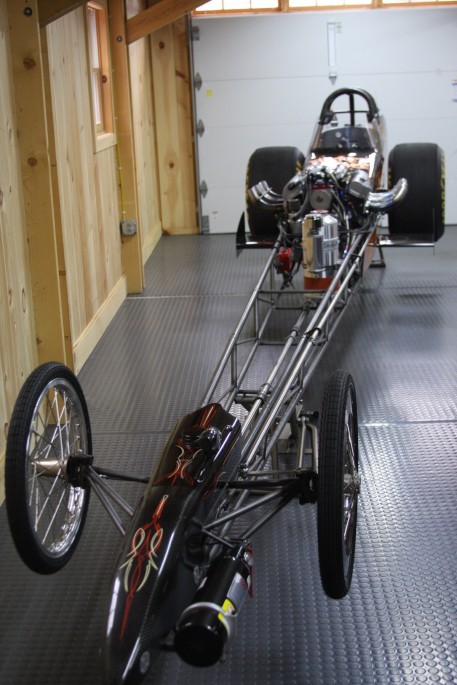
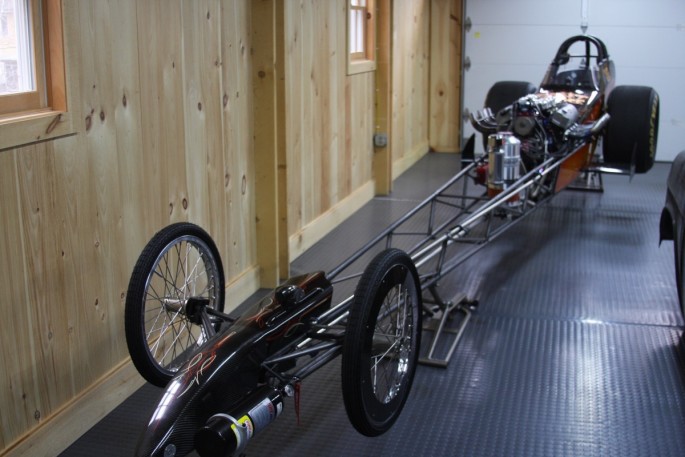
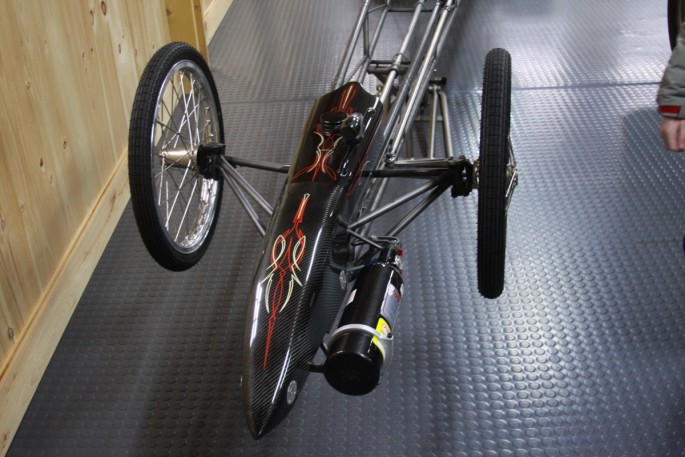
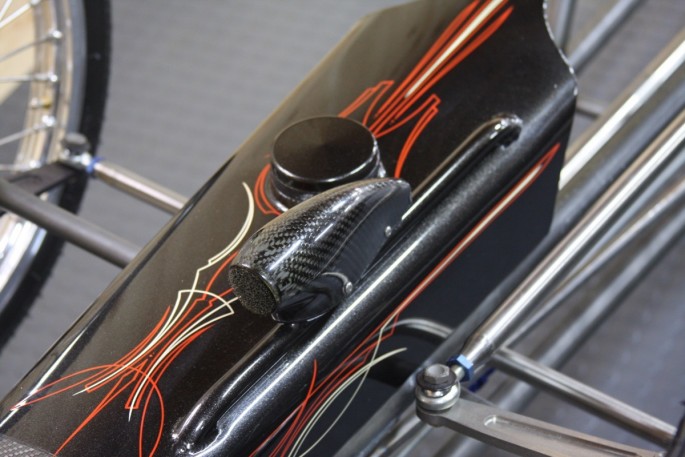

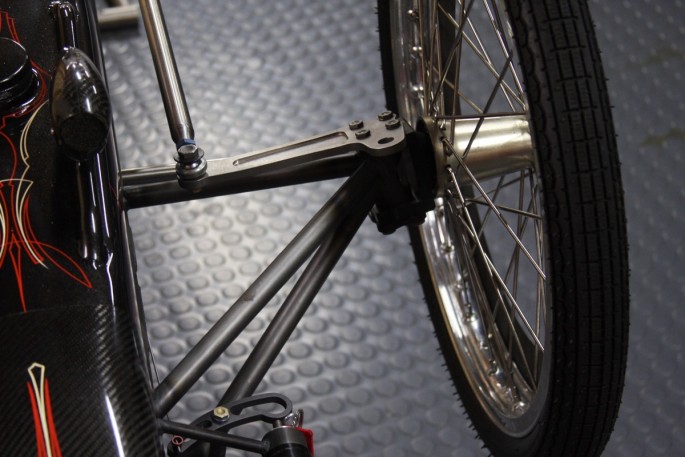
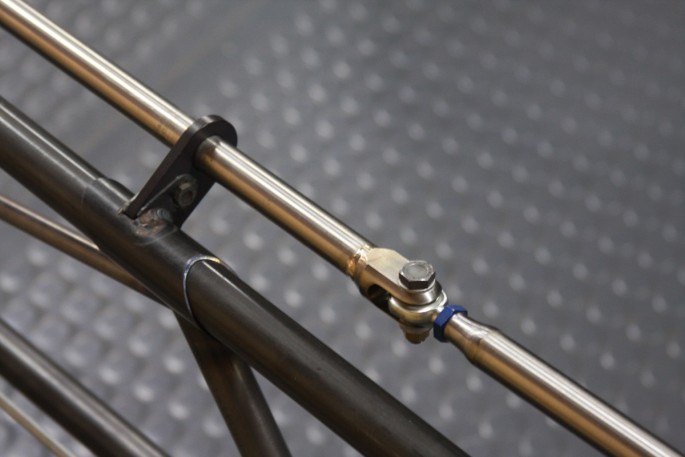
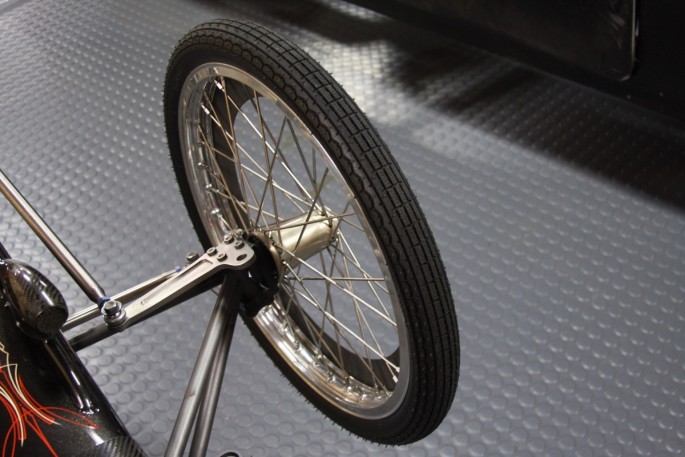
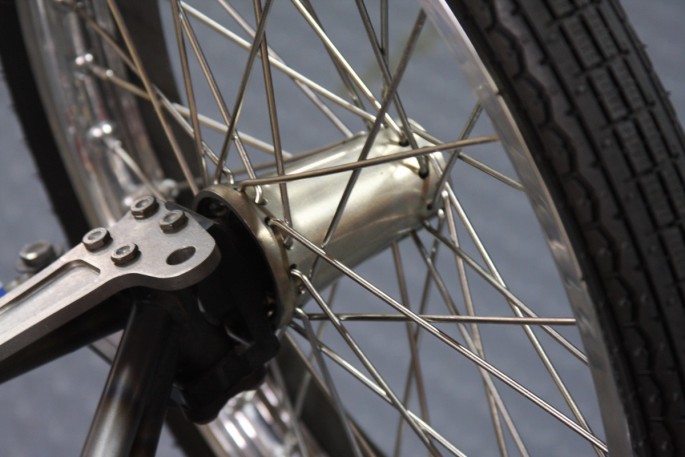
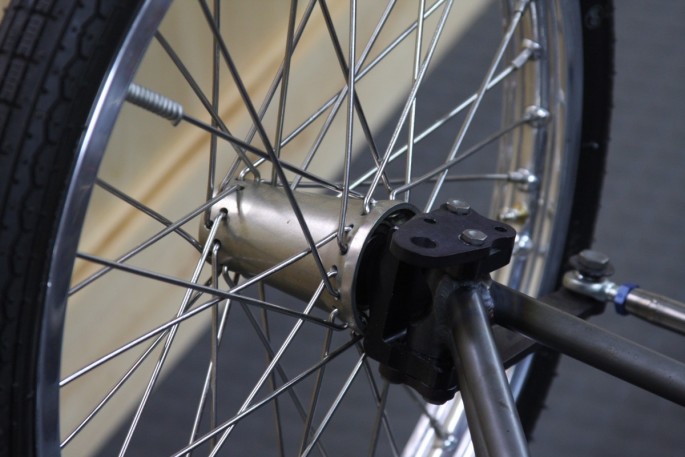
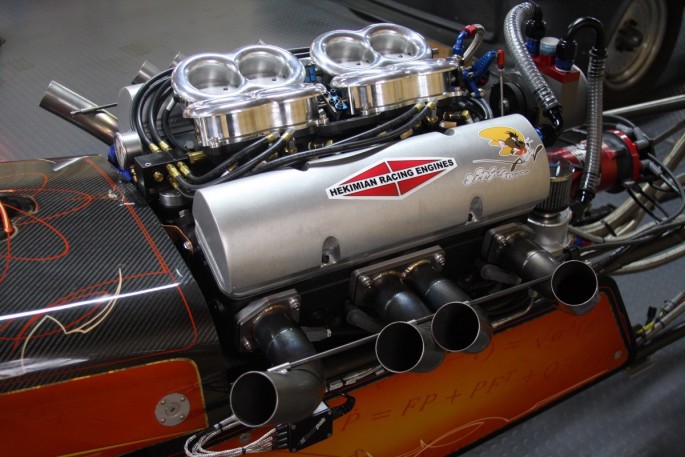
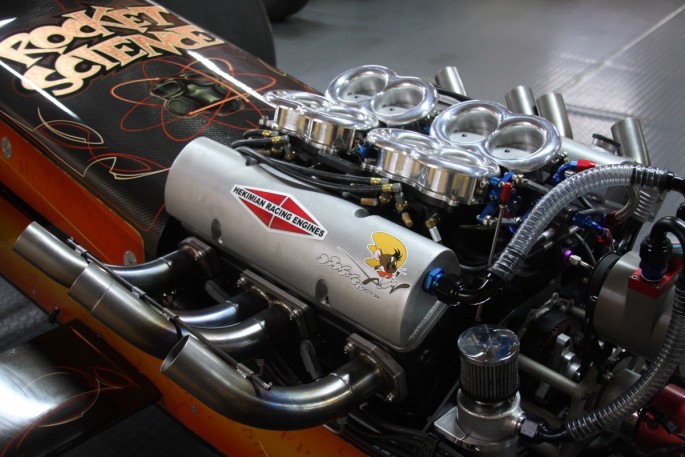

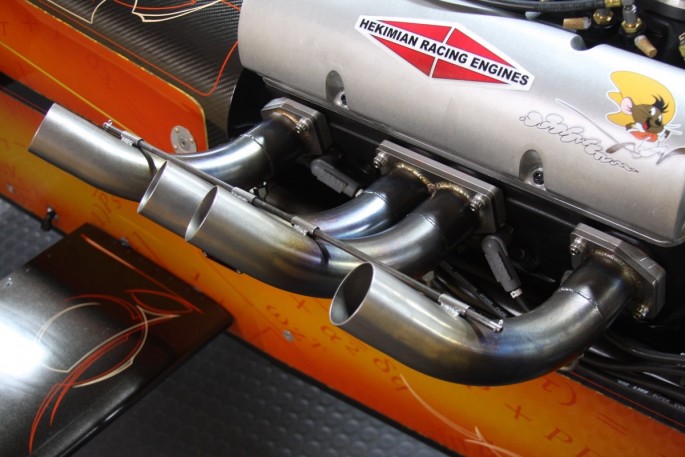


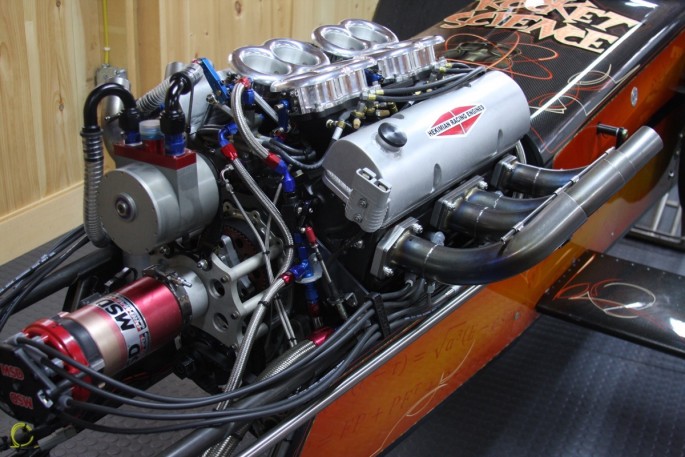
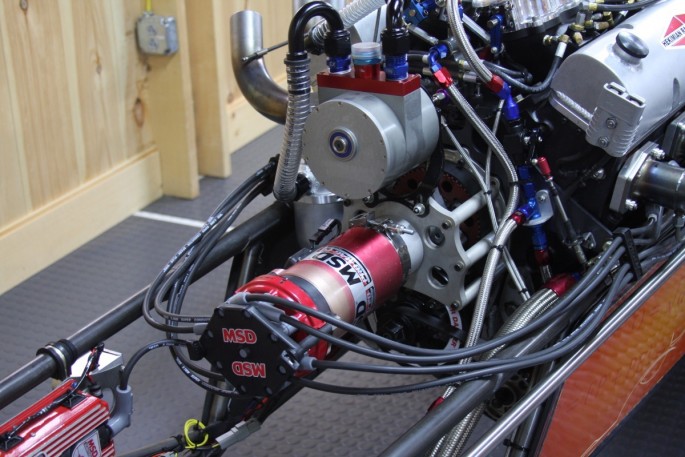

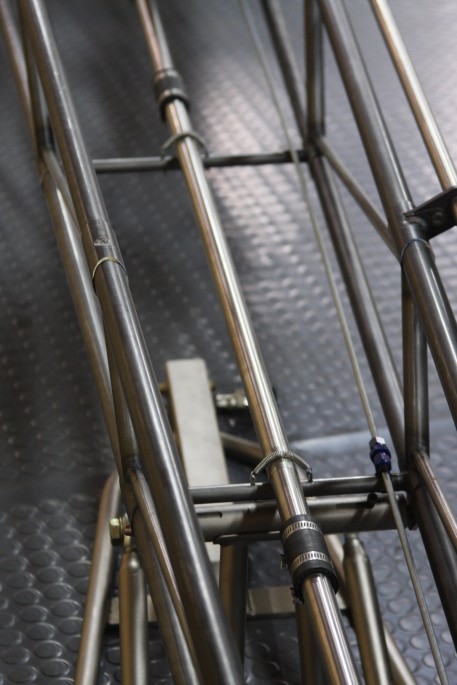
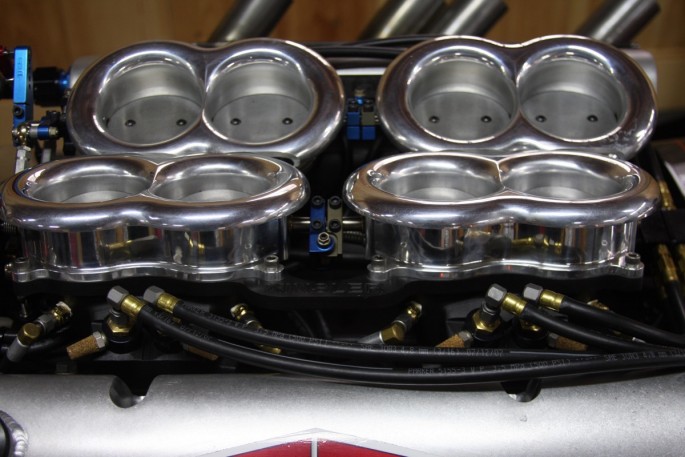
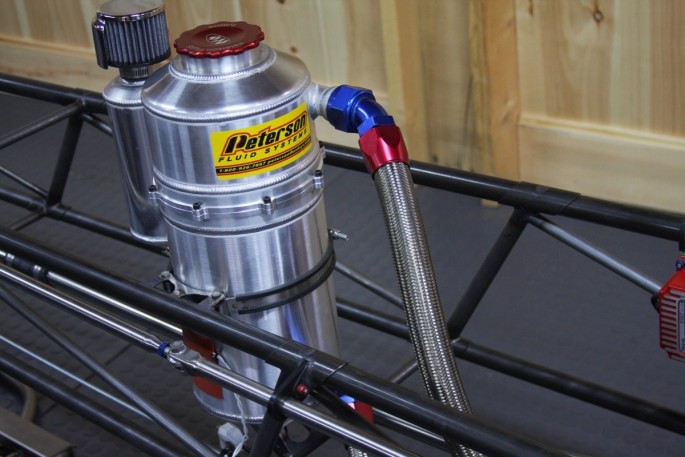
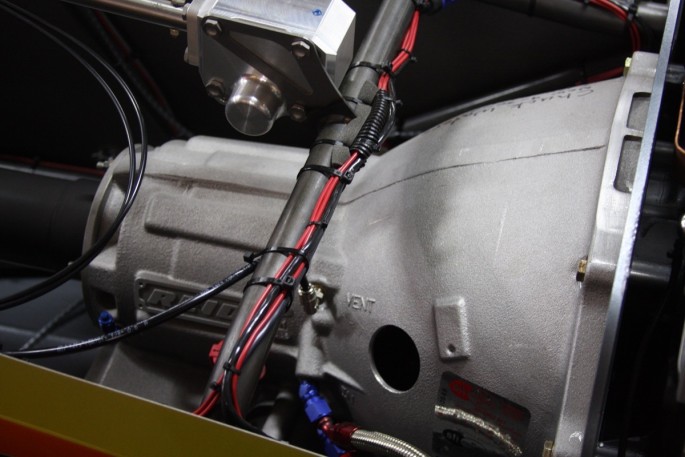

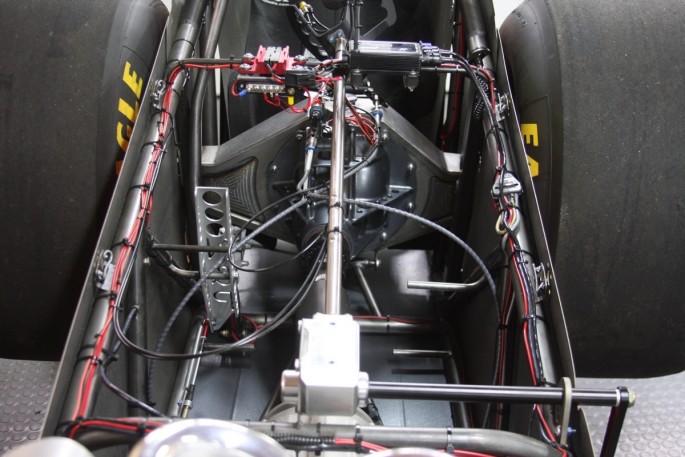
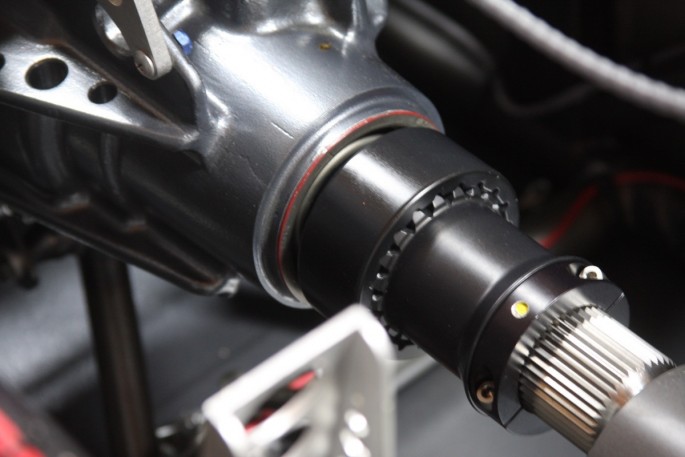
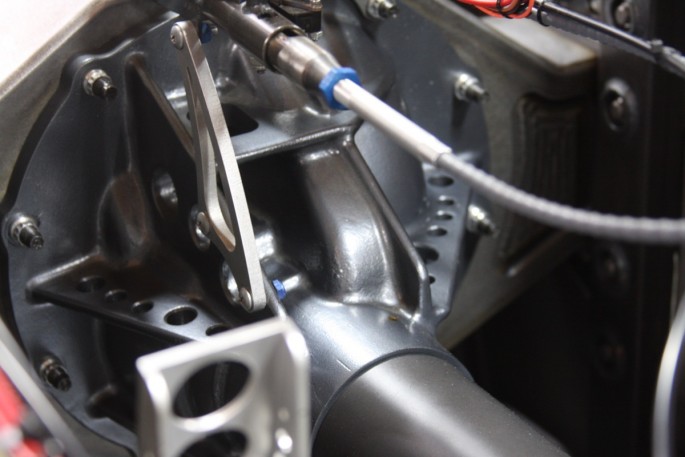

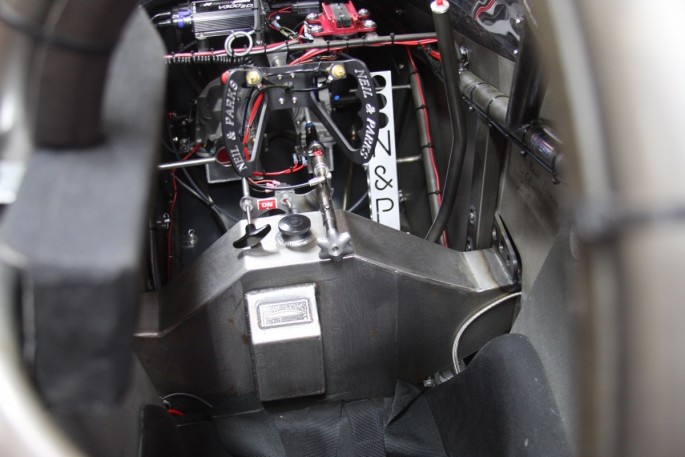






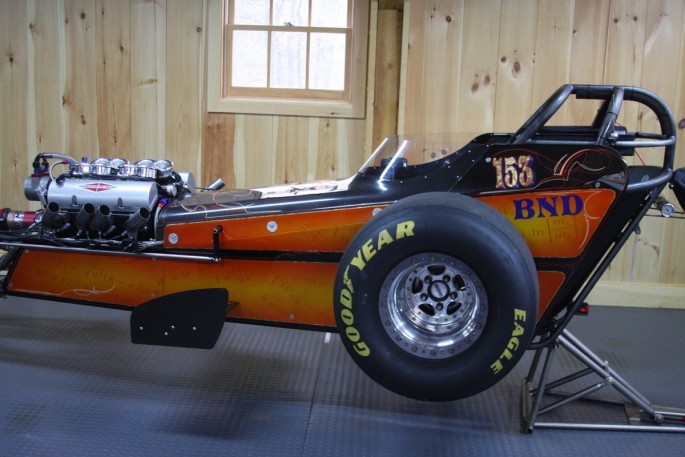

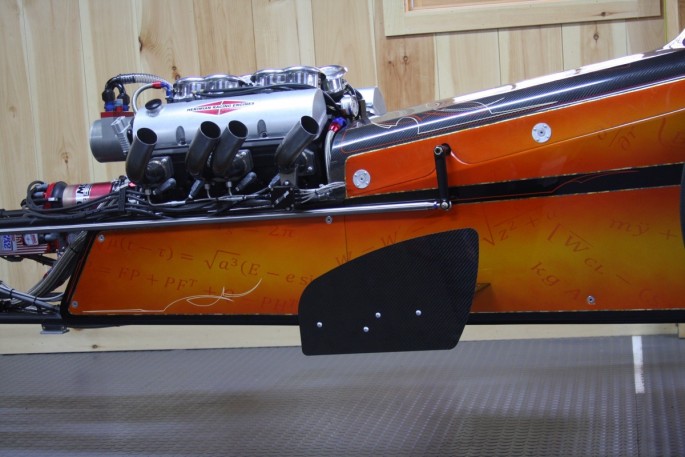

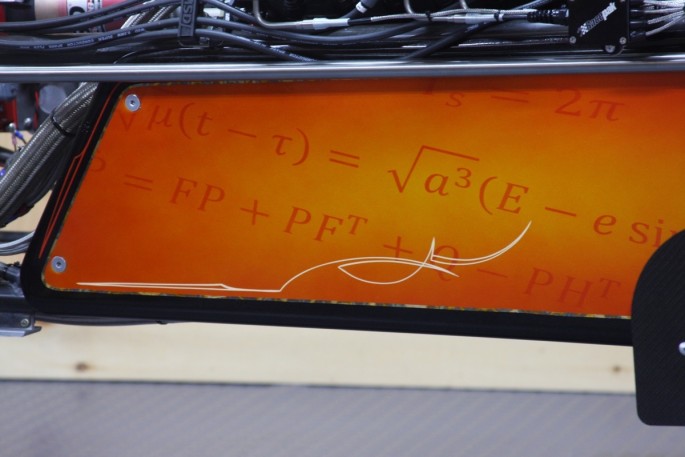

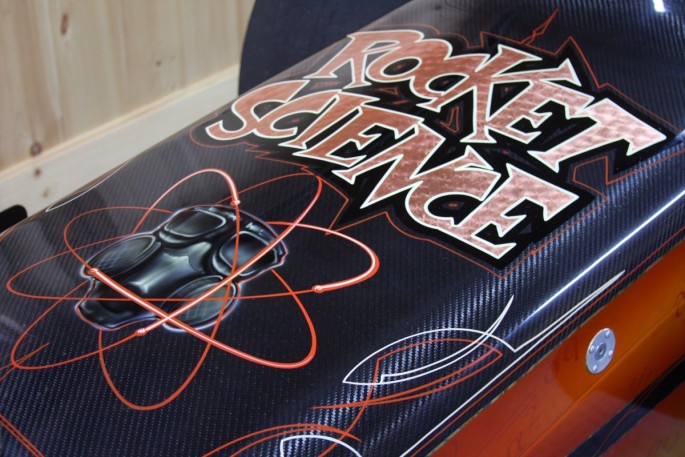
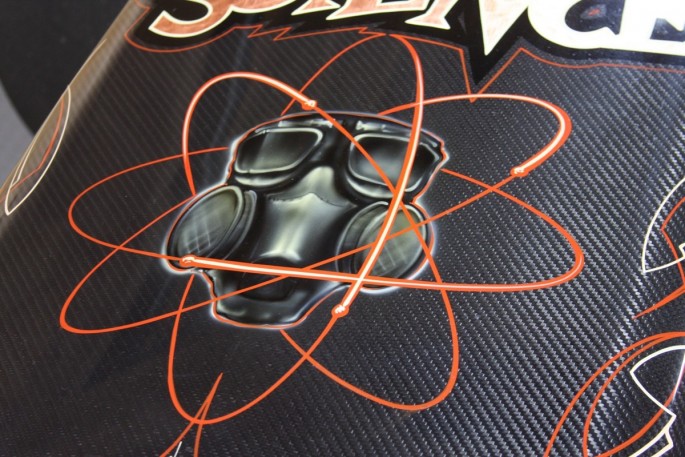
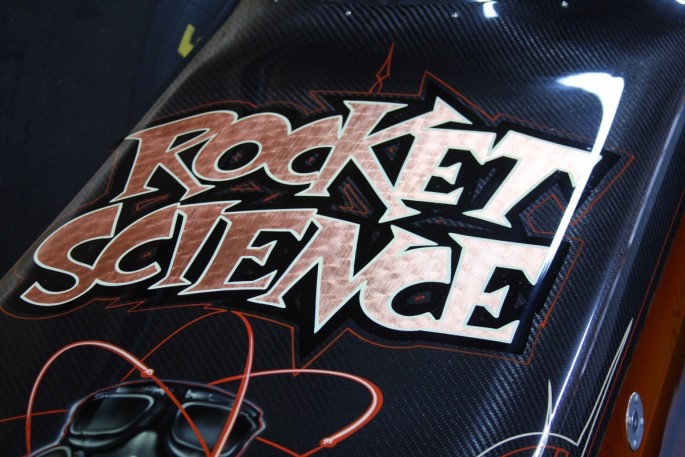

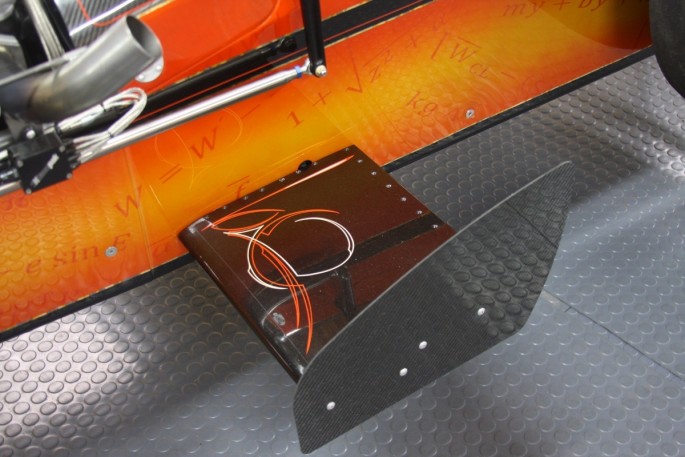

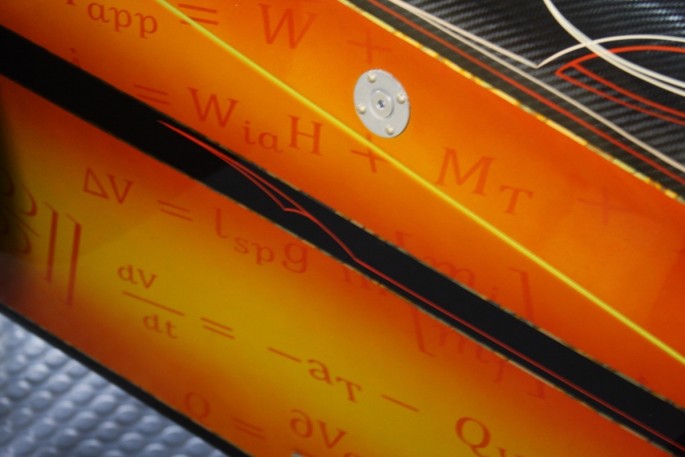

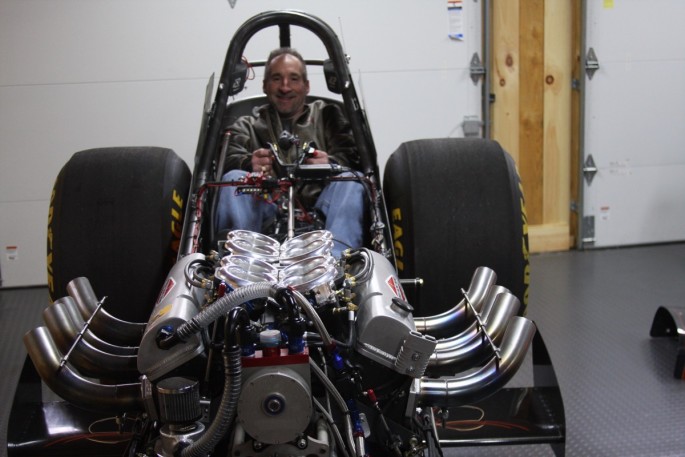








who made the vacuum pump????? EXPERTS??????? i wonder what numbers that unit makes
Nice job on the write-up
Vac pump is a Star Machine mountain motor pump
The same has happened in the UK with so-called “classic” saloons (sedans).
I religiously watch every St.Mary’s Trophy race in the Goodwood Revival and am always confronted with cars such as the humble and slow Austin A30 blasting along the track and even beating V8 engined monsters running cars powered by 1500cc plus full race screaming A series motors and all coil sprung suspensions when the originals packed 998 cc lumps of dough that couldn’t escape their own shadow. But such is progress and I for one am not complaining!
way too much technology and cost for us. we run a buick powered1968 fed built to ’68 visual specs and we will never go that fast which is fine with us.
With all the top-notch engineering and attention to detail, it’s a shame they misspelled the word “principles” on that metal box.
That’s the joke.
Mechanical Engineers are not the best at spelling words. LOL
I got to get a close up look at Neil & Parks’ “shop car”, the A/ND that Scott Parks drives, at a LODRS race at Seattle a couple of years ago. They build some of the trickest race cars around.